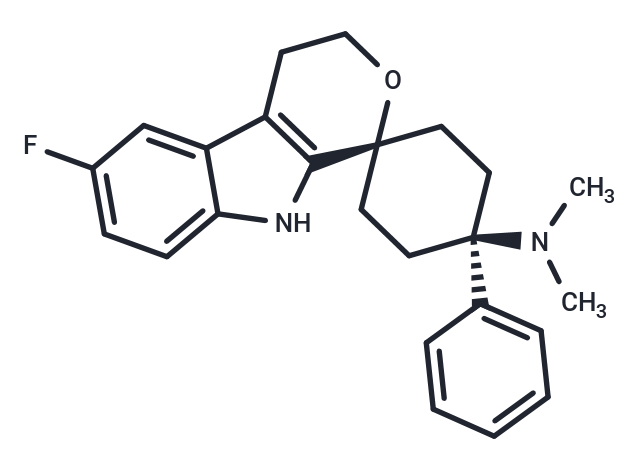Shopping Cart
- Remove All
 Your shopping cart is currently empty
Your shopping cart is currently empty

Cebranopadol (GRT6005) is an analgesic NOP and opioid receptor agonist with Kis of 0.9 nM, 0.7 nM, 2.6 nM, 18 nM for human NOP, μ-opioid (MOP), κ-opioid (KOP) and δ-opioid (DOP) receptor, respectively.

| Pack Size | Price | Availability | Quantity |
|---|---|---|---|
| 2 mg | 32 € | In Stock | |
| 5 mg | 52 € | In Stock | |
| 10 mg | 84 € | In Stock | |
| 25 mg | 169 € | In Stock | |
| 50 mg | 274 € | In Stock | |
| 100 mg | 406 € | In Stock | |
| 200 mg | 591 € | In Stock | |
| 1 mL x 10 mM (in DMSO) | 57 € | In Stock |
| Description | Cebranopadol (GRT6005) is an analgesic NOP and opioid receptor agonist with Kis of 0.9 nM, 0.7 nM, 2.6 nM, 18 nM for human NOP, μ-opioid (MOP), κ-opioid (KOP) and δ-opioid (DOP) receptor, respectively. |
| Targets&IC50 | μ opioid receptor:1.2 nM (EC50, cell free), NOP:13 nM (EC50, cell free), δ opioid receptor:110 nM (EC50, cell free), κ opioid receptor:17 nM (EC50, cell free) |
| In vitro | Cebranopadol showed full agonistic efficacy at the human MOP and DOP receptors, almost full efficacy at the human NOP receptor, and partial efficacy at the human KOP receptor. In a functional [35S]GTPgS binding assay with membranes expressing the human 5-HT5A receptor, cebranopadol did not show agonistic or signirficant antagonistic effects at concentrations up to 10.0 μM [1]. |
| In vivo | Cebranopadol displays potent and efficacious antinociceptive and antihypersensitive effects in various rat models of acute and chronic pain, with ED50 values ranging from 0.5-5.6 μg/kg intravenously and 25.1 μg/kg orally. Its action lasts up to 7 hours intravenously (12 μg/kg) and over 9 hours orally (55 μg/kg) [1]. In streptozotocin (STZ)-treated rats, cebranopadol (i.pl.) reduced mechanical hypersensitivity in the ipsilateral paw without affecting the contralateral paw. In CCI rats, cebranopadol (i.pl.) exhibited antiallodynic activity in the ipsilateral paw and, following administration to the contralateral paw, demonstrated ipsilateral antiallodynic activity with reduced potency and delayed onset. In diabetic mice, cebranopadol (i.th. and i.c.v.) effectively decreased heat hyperalgesia with similar potency for both routes [2]. In NOP(-/-) mice, morphine induced withdrawal symptoms comparable to those in NOP(+/+) animals, while cebranopadol elicited a more pronounced withdrawal syndrome in NOP(-/-) than in NOP(+/+) mice [3]. |
| Kinase Assay | Rat MOP, KOP, and NOP receptor binding assays were run using membrane suspensions from rat brain without the cerebellum for MOP receptors; without the pons, medulla oblongata, and cerebellum for NOP receptors; and without the pons, medulla oblongata, cerebellum, and cortex for KOP receptors and the following tritium-labeled radioligands: [3H]DAMGO in the MOP receptor assay, [3H]nociceptin in the NOP receptor assay, and [3H]Ci-977 in the KOP receptor assay. The assay buffer used for the binding studies was 50 mM Tris-HCl (pH 7.4) supplemented with 0.05% sodium azide. The final assay volume of 250 μl/well included 2 nM [3H]DAMGO, 1 nM [3H]nociceptin, or 1 nM [3H]Ci-977 as a ligand in the MOP, NOP, or KOP receptor assays, respectively, and cebranopadol in dilution series. Cebranopadol was diluted with 25% DMSO in water to yield a final 0.5% DMSO concentration, which also served as a respective vehicle control. The assays were started by the addition of the membrane suspensions and, after short mixing, the assays were run for 90 minutes at room temperature. All incubations were run in triplicate and terminated by rapid filtration under mild vacuum and two washes of 5 ml of buffer using FP-100 Whatman GF/B filter mats. The radioactivity of the samples was counted after a stabilization and extraction period of at least 15 hours by use of the scintillation fluid Ready Protein; the complete competition curves for cebranopadol were recorded [1]. |
| Animal Research | The pharmacokinetic properties of cebranopadol in rats were investigated after a single intravenous dose of 160 μg/kg cebranopadol. The intravenous dose was administered as a bolus in a volume of 2 ml/kg with a catheter in the vena femoralis. Blood samples (200 μl/sample) were withdrawn via an implanted arterial catheter (arteria carotis) by an automated blood sampling system at the following sampling times: 0 (predose), 5, 15, 30, 60, 180, 360, 720, and 1440 minutes after administration. Blood samples were centrifuged, and plasma was separated. Plasma concentrations of cebranopadol were determined using a validated liquid chromatography-tandem mass spectrometry method. The lower limit of quantification for cebranopadol in this method was 0.05 ng/ml using a sample volume of 50 μl of plasma [1]. |
| Alias | GRT6005 |
| Molecular Weight | 378.48 |
| Formula | C24H27FN2O |
| Cas No. | 863513-91-1 |
| Smiles | CN(C)[C@]1(CC[C@@]2(CC1)OCCc1c2[nH]c2ccc(F)cc12)c1ccccc1 |
| Relative Density. | 1.23 g/cm3 (Predicted) |
| Storage | Powder: -20°C for 3 years | In solvent: -80°C for 1 year | Shipping with blue ice. | ||||||||||||||||||||
| Solubility Information | DMSO: 5 mg/mL (13.21 mM), Sonication is recommended. H2O: Insoluble | ||||||||||||||||||||
Solution Preparation Table | |||||||||||||||||||||
DMSO
| |||||||||||||||||||||

Copyright © 2015-2025 TargetMol Chemicals Inc. All Rights Reserved.